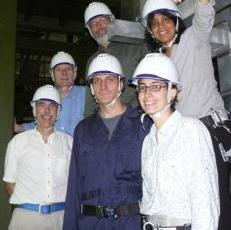
The OTR team from bottom left, clockwise: D. Morris, M. Cadabeschi, J. Martin, S. Bhadra, A. Marino, V. Galymov. Missing: A. Konaka, P. de Perio, L. Stawnyczy
The Optical Transition Radiation (OTR) detector for the T2K experiment is the most downstream monitor in the proton beam line at J-PARC. It was developed over the past two years by a collaboration from York University, the University of Toronto, and TRIUMF, and was successfully deployed in September and October this year.
The T2K (Tokai to Kamioka) experiment at J-PARC in Tokai is a long-baseline neutrino oscillation experiment and requires a very intense and accurately positioned proton beam. This beam will collide with a graphite target to create pions. The pions will be focused by three magnetic horns before decaying to produce muon-neutrinos. The neutrino “beam” passes through a near detector, components of which are being built at TRIUMF, on its way to the Super-Kamiokande detector situated 295 km away on the other side of Japan. Studying the properties of neutrinos through the oscillation mechanism, in particular the oscillation from muon-type to electron-type neutrinos, is the main physics goal of T2K.
Several beam position monitors will be used to locate the proton beam at low intensities and assist in guiding the beam through the transport pipe from the 50 GeV accelerator to the proton target. The final monitor, located about 200 mm upstream of the target face, must be able to operate at the full beam intensity.
The OTR monitor uses optical transition radiation, the emission of visible photons when energetic charged particles traverse a boundary between media with different dielectric constants (in this case helium to titanium). An eight-position carousel (see banner image) holding titanium alloy foils is placed at 45 degrees to the incident proton beam, so that backward going OTR light from the foil in the beam is reflected at 90 degrees to the beam. A stepping motor located at the top of the horn/target support module is used to rotate the carousel from one foil to the next. Due to the intense radioactivity near the target area, the OTR photons are transported in a dogleg path through iron and concrete shielding by four aluminum 90-degree off-axis parabolic mirrors to a less hostile location where a radiation hard camera will survive. The mirrors focus the OTR light to an image which provides a beam profile. A crucial element is the monitoring of the alignment of the OTR system. A calibration foil with precisely machined fiducial holes (see banner image) will be rotated periodically into the beam position. Images of the holes can be taken using back-lighting from lasers and filament lights.
The camera captures an image of each beam spill, occurring every 2.5 seconds. The image is processed in a data acquisition computer, and information is generated which identifies characteristics of the beam position and shape. The DAQ uses the MIDAS data acquisition system developed at PSI and TRIUMF. A beam abort can be issued to the accelerator group if the beam is too narrow (target protection) or too wide (too much local radiation generated). The beam position, which affects the neutrino beam angle, will be measured to less than a millimeter.
Installation of the foil carousel and motor drive, mirrors in support tubes, and camera on a temporary platform was carried out in September and October during a period of intense activity on many fronts in the T2K target station building in preparation for first beam April 2009. Preliminary tests of alignment calibration systems were successful.
Article By: D. Morris, M. Cadabeschi, J. Martin, S. Bhadra, A. Marino, V. Galymov, A. Konaka, P. de Perio, and L. Stawnyczy
The authors would like to thank the staff in the workshops at the three institutions for manufacturing parts on a tight schedule.
Kaitlan Huckabone
TRIUMF's Communications Assistant
